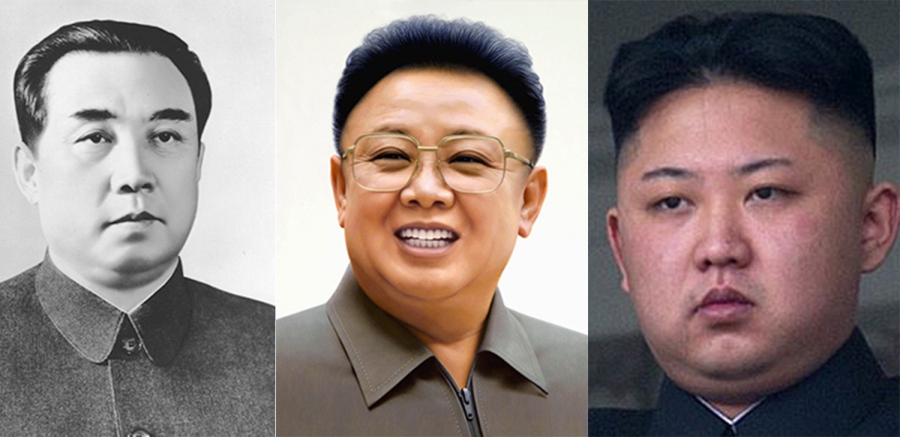President Trump began a historic summit with the North Korean dictator Kim Jong Un. Here are five facts you should know about the Kim family, the secretive autocratic regime that has ruled North Korea for more than sixty years.
(Note: To avoid confusion, I’ve labeled each of the Kim dictators with a numeric designation: Kim Il-sung, the grandfather, as K1; Kim Jong-il, the son, as K2; and Kim Jong-un, the grandson and current dictator, as K3.)
1. Following the surrender of Japanese forces in 1945, the Japanese empire was required to surrender all portions of Korea north of 38 north latitude to the Soviet Union and all of Korea south of that marker to the United States. That December, the Soviets installed a communist guerrilla leader named Kim Il-sung (K1) as the chairman of the North Korean branch of the Korean Communist Party. When the Democratic People’s Republic of Korea (DPRK) was formed in September 1948, the Soviets recognized Kim Il-sung (K1) as the leader of Korea, both North and South. Attempting to make his dream of unification a reality, Kim Il-sung (K1) launched the first military action of the Cold War by invading the Republic of Korea (ROK) in July 1950. An armistice was signed in 1953 that created the Korean Demilitarized Zone, separating North (DPRK) and South Korea (ROK). Because no peace treaty was ever signed, and because the U.S. has a mutual defense treaty with the Republic of Korea, the U.S. is positioned to go to war if the DPRK resumes attacks on South Korea.
2. Soon after taking control of his country, Kim Il-sung (K1) developed such a strong personality cult that under the DPRK constitution he remains, even in death, the “eternal President of the Republic.” Within a year of being appointed premier, Kim Il-sung (K1) was referring to himself as “The Great Leader” and erecting statues of himself (the country now has more than 500 statues of him). His birthday is a national holiday known as the “Day of the Sun”, and in 1997 Kim Il-sung (K1) even created a new calendar that recalculated time from the year 1912, when he “came to earth from Heaven.”
3. Kim Il-sung (K1) placed his son in positions of power so that in 1994 Kim Jong-il (K2) would become the “supreme leader” of the DPRK. Over the next three years, Kim Jong-il’s (K2) agricultural system would cause a famine that killed 3 million of the country’s 22 million people. (As The Atlantic’s Jordan Weissmann says, under the idea of Juche, a form of hyper-nationalism, “Farmers were expected to overcome mother nature and grow enough crops to feed the entire population.”) As his people starved, Kim Jong-il (K2) focused on a policy of songun (military first) to maintain the world’s fourth largest army.
4. Kim Jong-un (K3) became supreme leader after his father’s death in 2012. As the Pentagon explained in a report to Congress, since assuming control Kim Jong-un (K3) has “solidified his grip on power by embracing the coercive tools used by his father and grandfather.” The regime has used “force and the threat of force combined with inducements to quell domestic dissent and strengthen internal security; co-opt the North Korean military and elites; develop strategic military capabilities to deter external attack; and challenge the ROK and the U.S.-ROK Alliance.” In April 2013, notes the Pentagon report, Kim Jong-un (K3) announced the “byungjin” policy, which emphasizes the parallel development of the country’s economy and nuclear weapons program, to reinforce his regime’s domestic, diplomatic, economic, and security interests.
5. Kim Jong-un’s (K3) regime is intent on developing an intercontinental ballistic missile that can strike the U.S. with nuclear warheads. He believes this will help him reach his main strategic goal, which the Pentagon identifies as ensuring “Kim family rule in perpetuity.” The Pentagon also notes that the overarching national security objectives of Kim Jong-un (K3) have remained largely consistent: international recognition as a nuclear armed state; maintenance of a viable deterrent capability; the simultaneous development of its economy and nuclear weapons program (i.e., the “byungjin” line); reinforcement of its military-first approach to domestic and foreign affairs (“songun”); tight control over communications, borders, movement, and trade; and reunification of Korea under North Korea’s control.” The Defense Department says North Korea uses reunification with South Korea as a key component of its national identity narrative to validate its strategy and policies, and to justify sacrifices demanded of the populace.
—
[This Acton Institute article was republished with permission.]
Dear Readers,
Big Tech is suppressing our reach, refusing to let us advertise and squelching our ability to serve up a steady diet of truth and ideas. Help us fight back by becoming a member for just $5 a month and then join the discussion on Parler @CharlemagneInstitute and Gab @CharlemagneInstitute!
















Leave a Comment
Your email address will not be published. Required fields are marked with *